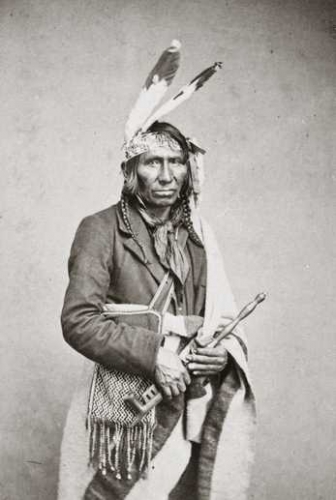Snow Blind!
Snow Blind!
Transcription and commentary by Mark Smith, OHS secretary
The following letter was written by Reverend Peter Dougherty in March of 1852 to Walter Lowrie, former U.S. Senator and (starting in 1838) the corresponding secretary of the Presbyterian Board of Foreign Missions. Lowrie was Reverend Dougherty’s supervisor and Dougherty depended on the organization for funding for his mission. This letter records details of a trip to Little Traverse by Dougherty, made in the dead of winter. At this time the “Old” Mission on Old Mission Peninsula was slowly being moved to the “New” Mission in Omena, where a school would be built for local Anishinaabe children. (See here for the story of Grove Hill School) At the same time, the Presbyterian Board of Foreign Missions was also attempting to establish a mission in Little Traverse, which would be run by Andrew Porter, uncle of John Porter (see here for the story of John Porter). The site of the Little Traverse mission was on present day Spring Street in Petoskey.
It seems that Andrew Porter’s mother and sister would be staying with a Mr. Whiteside in Old Mission until such time as there was proper accommodation for them in Little Traverse. Mr. Whiteside was a teacher at Old Mission up until the summer of 1852. Interestingly, on Aug. 8th, 1851, Whiteside sold his melodeon to Mr. Joseph Dame of Northport for $60, who then either sold or gave it to Rev. Smith. This is the melodeon Mrs. Smith (Arvilla) would play at church services in the old log cabin/church/meeting house at The Bight, north of present day Northport.
Of particular interest here, as in all winter letters from the early settlers, is the extreme hardship and isolation of Michigan winters. Nothing was easy, everything was difficult, and yet they persevered, largely due to the wide range of practical skills each and every one had to possess to survive.
••••••••••••
Walter Lowrie, Esq.
Grand Traverse March 9th 1852
Dear Sir,
I started on the first day of March for the Little Traverse. We were three days going. It is quite a formidable job after a tiresome day’s walk to dig away the snow, some two and a half feet deep, and get a camp made and wood cut to keep comfortable when the thermometer is from 6 to 8 degrees below zero. What was the worst we had one cold bright day and having no protection for my face it was very badly burned & my eyes were very painful. I was affected with what they call snow blind. I suffered on my way back very much with my face and eyes. The worst is past and today I am quite comfortable. Today is the first I can see to read or write.
I found the lot they had reserved for the school a very good location and will send a draft to the land office by our next mail to make the purchase [Dougherty is referring here to the Bear Creek Mission, in present day Petoskey]. There is but 40 acres in the lot. This I would judge is enough at the present. If more is needed it can be purchased again. There is land adjoining South unsold which can be examined hereafter if desired. I will draw on three days for fifty one dollars and have it entered in your name as the other was.
The plan and estimated times of expense for the building here [in Omena] I sent by the last mail. As to the nails and glass, I am inclined to think both are produced west of New York cheaper than they can be purchased and shipped from there. Of this you can judge when I state the price at which they are offered here. Mr. Cowles [of Northport] offers nails at $5 per 100 lb. The freight from New York is about [smudge] /hundred, the expense of cartage there, the charges for wharfage & storage at Mackinac is some thing. The risk of breakage or loss is considerable and the freight from Mackinac here is three shillings barrel bulk. These have to be added to the cost price in the city. Knowing these facts you can judge from the prices at which the board can [be] purchased there which will be most economical.
Ten by twelve glass good quality (50ft) can be delivered here for 18 or 20 cents per box.
I find by the duplicate of a young man here [it is not clear to where Dougherty is referring, but it is probably Little Traverse/Bear Creek] who was supposed to have bought the lot adjoining the school lot. He has notify mistake [sic]. He has bought on the other side of the section line. I will therefore buy the 80 acres and if he desires to have the lot it can be transferred on his paying the money for it. I will probably have to draw before long to purchase a yoke of oxen. Mr. Porter’s mother and sister can find accommodation in the house with Mr. Whiteside or some other house here.
The following is a bill of lumber for the school house [in Omena]: Clipping below. The entire letter can be downloaded here.https://digital.history.pcusa.org/





